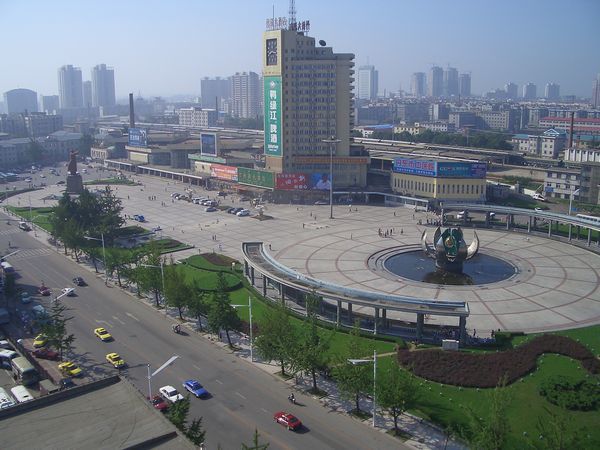Dandong 丹东
Dandong, Liaoning
Introduction
Location
Background
Weather
Transport
Dandong Sights
Dandong Hotels
Dandong Introduction
Most medium-sized cities in China tend to be of a kind and somewhat blur together. There's generally not a lot of sites of great interest to international visitors.
One of the things China is blessed with is a vast number of cities with a handful of million people and simply not much of a reason for travellers to go out of their way to visit them.
Dandong is not one of those cities.
It is, quite frankly, the most interesting city of its size in China. And a large reason for that is it’s proximity to North Korea.
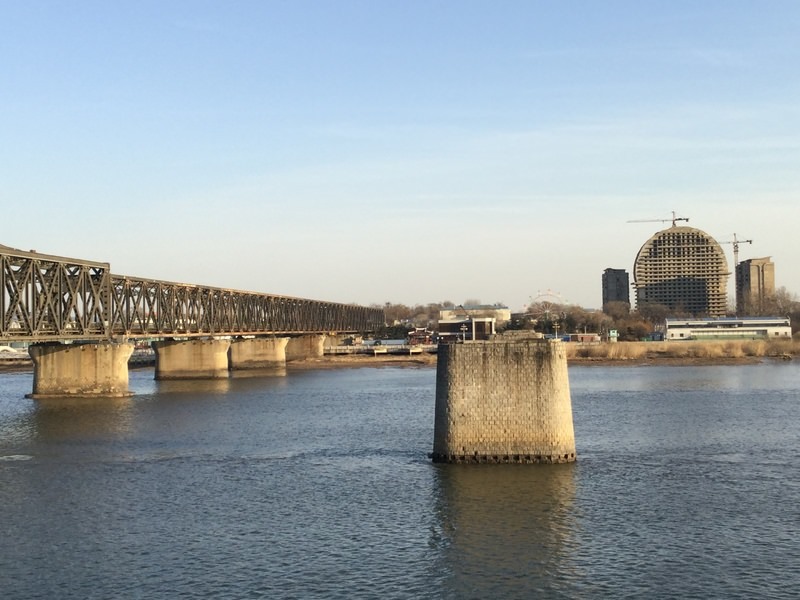
Dandong Location
Dandong is located in Liaoning Province bordering North Korea. It is claimed by locals as the largest border city in China.
For visitors, there is a great deal to do in Dandong.
While many people will simply pass through on their way into/out of North Korea on the train they will be missing out, a day or two in Dandong adds a lot to a visit to North Korea and also gives a sense of how different things can be when just separated by 900m of water.
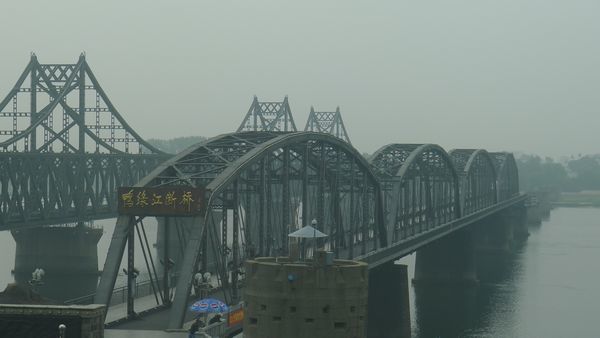
Dandong Background
Inhabited for millennia and having passed through the hands of a vast array of Dynasties through the long history of China, Dandong really came into its own starting in the late 19th Century.
At that time, Dandong was known as Andong. This is a term that means ‘pacify the east’, and taken as a commentary of the power China exercised over Korea at that time.
Japanese troops seized the city and the area during the first Sino-Japanese War in 1894 and it became part of the puppet Manchukuo state during the general Japanese occupation of the entire region (including Korea).
Following the defeat of the Japanese, Dandong and the rest of China came under the control of Mao Zedong’s communists. When the People’s Republic of China was declared in 1949, it was already a frontier city, since North Korea itself had been declared in 1948.
Almost immediately Dandong became a frontline city in the next conflict, the Korean War.
Starting in 1950, this conflict risked expanding regionally as the Chinese ‘Volunteer’ Army got involved and poured over the Yalu Rover from various points - including Dandong.
The Sino-Korean Friendship Bridge, built in the Japanese era, was bombed by American forces to slow this advance and even now the ‘Broken Bridge’ remains the most famed site in the city.
Andong as a name was considered inappropriate, and the name ‘Dandong’ was awarded in 1965. This simply means ‘Red East’. It’s a classic communist name, and at least sounds similar to the previous moniker.
Since then, Dandong has grown, modernised, been renovated, and become a prominent city in China.
Situated close to where the Yalu River empties into the Yellow Sea, Dandong is a key point for shipping, wildlife (migratory birds especially), now, and into the future.
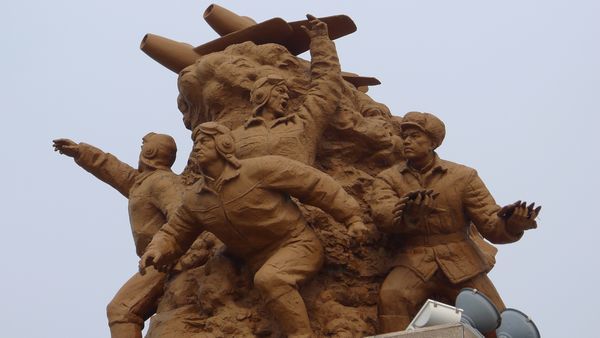
Dandong Weather
What is the weather like in Dandong?
Part of Dongbei (东北), the North East of China, Dandong experiences bitter and prolonged winters. Winters last 4 months with sub-zero temperatures common.
If visiting Dandong between Nov and March, you need to wrap up warm!
Summer is hot though, even with coastal winds keeping things not as boiling as they could otherwise be. Rain is more common in summer than other times but in general, Dandong is far from unvisitable at any time of year.
Dandong Transport
How to get to and travel around Dandong?
FLIGHT
Dandong Lantou Airport is a small place. It was built originally for the PLA Airforce to share with their North Korean counterparts during the Korean War.
While not a major airport (even in a regional sense), there are daily departures to Beijing as well as regular flights to Shanghai and other spots around the country.
Lantou Airport is around 20km from downtown Dandong and to get there simply take a taxi, around a 30 min journey most of the time.
TRAIN
This is the main way to arrive in or depart from Dandong. You can either get the high-speed train or slow sleeper train.
Dandong station had a major upgrade in 2015 which sadly removed a lot of charm from the platforms (they are now large and empty rather than cramped and full of vendors and shops).
Regular trains depart from here to various destinations, as well as high-speed lines to Dalian (1 hour), Shenyang (1.5 hours usually, beating the slow train by several hours) and Beijing (6 hours).
Of course, the high-speed option costs more than the normal train and a 14-hour sleeper from Dandong to Beijing is still a good option for those who like to go at a more leisurely pace and also have a night’s sleep on this more relaxing way to move around.
Trains depart from Dandong to Pyongyang daily and in spring and summer sell out very quickly due to the very large numbers of mainland Chinese tourists who visit on standard 3-night trips to the North Korea which all start and finish in Dandong. The station itself has a few snack shops, a branch of Dicos (a Chinese burger chain), and within a few minutes’ walk you can find a Starbucks (in the Hilton Hotel building) and a KFC. Great if you have been in North Korea for a while and need your western fast food fix in a couple of hours between the train arriving from Pyongyang and departing onward to Shenyang and Beijing!
ROAD
The road system in the northeast of China is modern and generally in good repair.
There are long-distance buses which get you to Beijing in around 10-12 hours, Shenyang in 3, Dalian in 4, but these for most people are secondary options to consider when the train is properly full.
The railway bridge from Dandong to Sinuiju in North Korea is also a road bridge but mostly for cargo, human passengers use this bridge for day trips to Sinuiju, or which there can be up to a dozen busloads of people at high season.
BOAT
There is a regular ferry from Dandong to Incheon in South Korea.
A trip that takes around 14 hours overnight. The seas here are usually calm and the journey is pleasant. Various classes of accommodation are available from private rooms to small dorms of 6-8 beds.
This is a very good option for anyone heading to South Korea after a trip to the North as it avoids having to backtrack as far as Shenyang, Dalian, or Beijing to catch a more expensive flight.
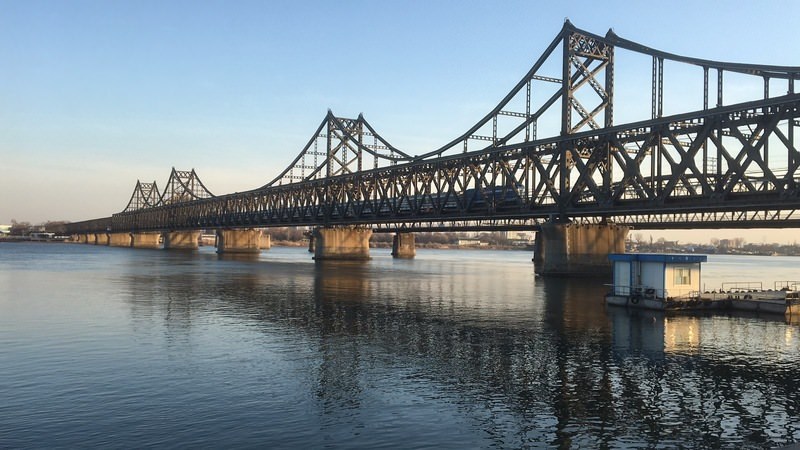
Dandong Sights
What to do in and around Dandong?
Yalu River Broken Bridge
Dandong’s most famous site, and in fact only one of several ‘broken’ bridges along the Yalu river between China and North Korea.
This Japanese-era iron bridge was bombed by the US Air Force in the Korean War and only the Chinese side stands these days. The supports on the Korean side make for good photos from the truncated end of the bridge (where of course you can buy some odd souvenirs, this is China!) and it is commonly believed that this halfway point across the river is the literal border of China/North Korea. In fact, the river itself is a border, so you are no more in China or North Korea standing at this point as if you were a metre into the water on either side.
This allows for boat trips to skim the shore or either side fully legally also.
At the land-end of the bridge is a statue showing General Peng Dehuai leading his Chinese Volunteer Army into Korea, to turn the tide in the conflict subtly known here as the ‘War to Resist US Aggression and Aid Korea’.

Boat Trips
From the riverside next to the Broken Bridge, medium-sized vessels set off multiple times a day doing a route up and down this part of the river. They cross to the North Korea half and giving tourists from the Chinese side the chance to get close to the shore and gawp at Sinuiju’s dockyards, waterfront restaurant, abandoned funfair, and a bit more.
From time to time, boats from North Korea do the very same thing (look for the flags).
This is possible because there is no actual line up the middle of the river, and it is a shared border. So. you can be as deep in what seems to be the water of the other side as you like without technically crossing the border. Don’t test this out by swimming across and standing ankle-deep on the North Korean side though!
Further upstream, speedboats make similar trips, zipping between the North Korea mainland and Korean islands as well. Here you can see soldiers (careful with photos, they don’t like it!) and farmers.
The best advice given on the boat trips are that if you fall into the river from one of the Dandong city trips just swim to the Chinese side, if you fall in on a speedboat trip then don’t swim anywhere and wait for pickup!
Mao Zedong Statue
Outside Dandong railway station is the large red statue of the Chinese ‘Great Helmsman’ (actually many visitors to China are surprised to not see more Mao statues, they are not as common as seeing a Lenin in the former USSR at all).
Here he points towards Beijing, which may be meaningful, but also means he stands at an odd angle to the railway station and looks like he was put in at the wrong angle. Stop for a photo and if you need to meet someone in Dandong, this is the ideal place to arrange a rendezvous, as everyone knows where it is, and everyone can find their way to Mao.
Funnily enough, he used to be pointing right at the entrance of Real Love Nightclub, the very best nightspot in all of China. Sadly defunct now, but the memories of those who boogied on the spring-loaded dancefloor here live on forever!

Museum and Cenotaph of the War to Resist US Aggression and Aid Korea
Almost perpetually under renovation in the last years, this nevertheless is an important site to visit if you are in Dandong and it is open.
A hilltop museum showing the Chinese version of this conflict. It is a good companion to the Victorious Fatherland Liberation War Museum in Pyongyang.
China’s version still has heavy doses of propaganda but also approaches some part of the conflict with a little more subjectivity and subtlety. Sadly, as most exhibits are only in Chinese this can be a bit lost on visitors. So a guide here is a good idea.
With a good collection of the banners and equipment the Volunteer Army took to Korea, as well as an interesting display of the propaganda dropped onto American and Allied lines (some quite compelling actually; it’s hard not to sympathise with the idea that fighting for people who won’t even let you use the same water fountain or restaurant might sit uneasily with African American troops), outside the museum you can find a small collection of tanks and other vehicles used in the conflict.
A couple of hours here does a good job of showing the third side of this conflict.
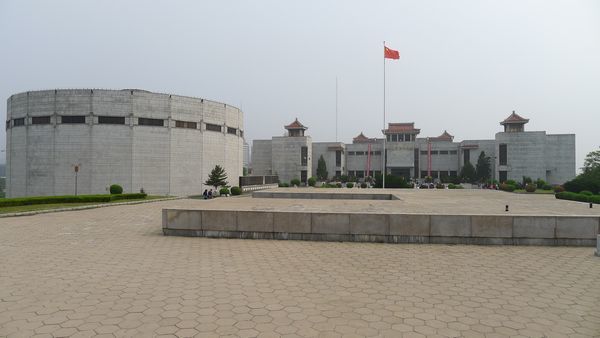
Waterfront Promenade
Along the Yalu river is now a wide walkway popular with both visitors and locals.
Being pestered by people trying to sell trinkets from North Korea can be a pain, especially as many of them are fake. The North Korea Leader pin badges especially - plus do not buy these and then take them into North Korea.
However, this boardwalk is especially good at night. Families come out, some local bands meet for music practice, calligraphers practice characters on the ground with water-dipped brushes, street food is on sale, it's all very pleasant and the kind of thing that should be offered in Sinuiju too… one day maybe!
Dandong Curio Market
Almost every Chinese city has one of these. An antique and general old stuff market.
This one is quite large though, spreading over several floors.
For those looking for a different kind of North Korean souvenir, this is a good place to come as you can find some medals, old money, and an ever-changing range of whatever these sellers can get their hands on from across the river; schoolbooks, uniforms, whatever really.
Prices are all negotiable (welcome to China!) but it is at least worth a look around here. The lower floors have some small art studios including some staffed by North Koreans painting Korean pictures for a mostly Chinese market.
Hushan Great Wall
Around 45 mins drive from Dandong centre is Hushan ‘Tiger Mountain’. This is the point where the Great Wall comes to an end (there are rival claimants to this title though, as the Great Wall was never a single or continuous wall after all). This heavily renovated site can be a bit touristy, but at least being updated makes it easier to walk along the steep pathways here.
The wall tops out at a cliff overlooking a large North Korean island, so you can wave to the farmers who toil just a few metres away. The river here is nothing more than a stream and freezes over for much of the year.
Small boats can sail up and down here too offering a way to get literally inches from North Korean soil. The embankment on the North Korean side is used by KPA Soldiers though. Do not get out and just jump across to North Korea for the fun of it. That may not end well!
The Great Wall here is not one of the most significant or ancient parts of the most famous landmark in China, but it is well worth visiting for some great views, and a leg workout too!
Russian Cemetery
Almost certainly Dandong’s least visited site is this small cemetery, hard to locate and looked after by an elderly farm lady who holds the only keys.
Find her and she leads you up a path to the gate which only she can unlock.
Inside, there is the main monument and a handful of other basic markers, with the names of Russian soldiers lost in local battels during their disastrous 1905 conflict with expansionist Japan.
It is a highly unexpected site to find here but for those with the time and inclination very much worth visiting. Nobody in the area seems to know much about it or even where it is. The lady with the keys knows nothing more than that it is a grave for Russians.
It backs onto a local cemetery that was originally for the Manchu Population (who still make up around 15% of the area’s people). There is also a Japanese cemetery on a nearby hill, from the same conflict.
New Dandong
As with many other Chinese cities, the smaller downtown area of Dandong has simply become too small for the swelling population, so the answer is to build a whole new city nearby.
Around half an hour’s drive from the centre of Dandong, this brand new city does, of course, look just like every other new Chinese city; complexes of towering apartment buildings, large boulevards cutting through the neighbourhoods, and so on.
Also, just like many of these new cities, the population capacity here far exceeds the number of people who have moved here. So while there is a need for more residential capacity in Dandong it seems people are still not too keen to move to a whole new city and at night you see very few lights on in many of the buildings. Not quite a ghost town, but in some parts, it does have that vibe.
So why visit here? The main reason would be the see the infamous “Bridge to Nowhere". This is a hugely expensive engineering feat which had China building a major road link over to mainland North Korea only for the road to end in a pile of dirt and nothing being built to connect it.
There are often reports that it will soon be integrated into the North Korean road system and start to be a major conduit for trade and travel, reducing the border on the overused smaller Friendship Bridge, but this is yet to become a reality.
Otherwise, there is not much to see in New Dandong apart form a swanky North Korean Consulate with expensive diplomatic cars parked outside, and that red brick British-Style house you pass on the way in and out of the new town? That was built for the former actual emperor and then puppet emperor Pu Yi to stay in when he came here to open the first hydro-electric dam in China (at the time both this part of China and the whole of Korea were under Japanese control and occupation).
Shuifeng Hydro-Electric Dam
China’s first hydro-electric power plant (although it was built by the Japanese) was opened here in 1937.
It still works to this day, and now stretches across a dammed section of the Yalu River between China and North Korea.
The two countries share the power generated at this point. While not actually a site to visit in and of itself this dam is well worth taking a drive out to as the views along the riverside road are excellent, there are a range of smaller broken bridges and viewpoints over to North Korea along the way too. There are also signs reminding people not to bother the North Koreans, not to try to send anything over the water, and weirdly not to take photos at certain points (which seems like the Chinese shouldn’t really be bothering with).
If you are a foreigner and going up this way, then take your passport as there are some spot checks by Chinese Police from time to time. It is an international border after all, even though it is a friendly one.
It takes around 2 hours to make a leisurely drive from Dandong to this dam, allow extra time for stopping for views and photos.
Beer
Most Chinese mass-market beer is terrible. But of all of them, Yalu River beer is the best.
This can be found all over the place, even though the despicable Snow Beer from Harbin is somehow even more ubiquitous. Actually, it's the world's most sold beer!
Yalu River beer is made in Dandong, so this is what you should drink when visiting here.
Some places also sell North Korean beer. Usually the inferior export variety, but from time to time the Pyongyang-quality stuff too.
Restaurants
There are a number of North Korean Restaurants in Dandong. Some on the waterfront, some inland.
These have North Korean staff and cooks and offer a good chance to try some DPRK style grub. They are mainly of interest for people who have not just been to North Korea, of course, and those who want to meet a real-life North Korean!
Dandong is also very good for barbeque restaurants and for seafood places. There are many riverside restaurants displaying tray after tray of live seafood in all its vast variety outside on the pavement for you to choose from before they cook it up for you.
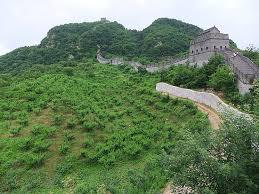
Dandong Hotels
Dandong may be a small city by Chinese standards, but anywhere with a million or two people certainly has a range of hotel options to choose from.
There are hostels, no-star dumps, and a wide range of basic Chinese brand hotel chains too.
We will just list a couple of the higher-end options here, not because all readers will be needy travellers, just that after a trip to North Korea it is usually a good call to treat yourself to a little luxury and the decent spots in Dandong offer comfort, Wi-Fi, hot water, and all those mod cons that you may have missed.
So try out one of these;
Zhonglian Hotel
The most famous in Dandong and situated right at the end of the Broken Bridge. River-side rooms often have telescopes or binoculars so you can get a better view over the Yalu River and into Sinuiju.
This is the first choice of places to stay. However, it could do with some upgrading and has rested on its location-laurels for some time for sure.
Sunny Resort
A couple of KM inland from the river so without much of a view, this is still a good option with larger rooms, decent conveniences, and also you often find North Korean groups staying here.
Mingle with these fellow foreigners and breakfast and see what they are up to!
Hilton Hotel
Rising above the fanciest shopping centre in Dandong, this place is what you would expect from a Hilton; very nice, but nothing particularly local about it.
If you have Hilton points or an absolutely need to not be more than 100 yards form a Starbucks then this is the place for you! T
his is the only hotel where you can reliably expect the front desk staff to speak English.
